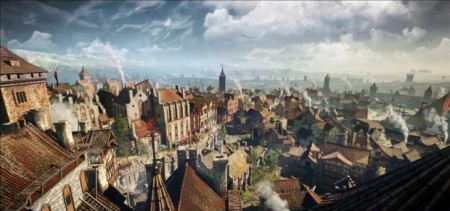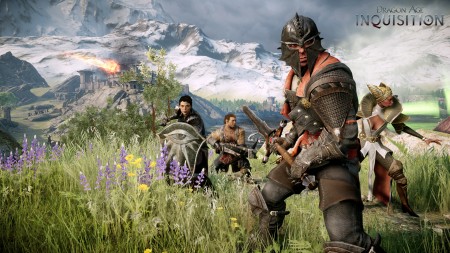The Reticule (Not at) E3 – Bioware and the Future of RPGS
Today The Reticule’s (not at) E3 Speculate-athon comes to an end as I take a look at Bioware’s sacrifices to the great gods of hype. With the possible exception of Robot Chicken Reggie at Nintendo Direct, Bioware’s trailers, demos and interviews stoked my excitement glands to the point where I’m considering actually investing in a PC capable of playing their games.
This year Bioware’s main offering was Dragon Age: Inquisition, the next instalment in the series, following on from 2011’s Dragon Age II. Whilst I still think DAII was something of a flawed gem, boasting some of the best characters and writing Bioware have produced, it was an undeniable set down from Dragon Age: Origins in terms of the scale of both the world and the plot.
I don’t think that’s going to be a problem in Inquisition. Everything Bioware put out at E3 pointed to a world larger than any other done so far in the series, a globe-trotting quest (I hear it involves saving the world) and a decent amount of player agency (decisions!). As the story goes, rifts have opened up across the land of Thedas, killing stacks of people, spewing out an unreasonable amount of demons and threatening to end the world in an orgy of destruction. It’s fair to say that this might sound just a little bit like Origins, which also involved a quest to stop an army of sort-of demonic creatures threatening to end the world in an orgy of destruction. However, whilst that particular quest involved doing a number of fairly linear quests in any order, much like most other pre-Mass Effect 3 Bioware games, Inquisition is doings things just a bit differently.
[youtube http://www.youtube.com/watch?v=FfGTtyYeO8E]
Talking to IGN at E3, Creative Director Mike Laidlaw detailed how the player, as head of the titular Inquisition, will travel the world in order to recruit inquisitors and build the strength and renown of the organisation. The E3 demo showed the player travelling through the mountainous Hinterland area in order to end a local conflict between rogue mages and the Templars who, in the world of Dragon Age are more or less meant to stop the mages from being possessed by demons through the time honoured method of stabbing. Whilst it wasn’t evident from the footage shown, this war manifests itself in the form of dynamic fights across the area which refresh themselves – small scuffles which play out until the larger issues are solved.
The upshot of this seems to be that the player has the ability to have a substantial affect the world, rather than having their choices played out in cutscenes or summations of the narrative as has been the case with some past Bioware titles.
We saw plenty of the combat, too. The tactical, almost top-down, combat of Origins seems to have melded with the hack and slash of the second game to produce something with shades of both games. Mike Laidlaw suggested that combat could be played to either extremes; focusing on real-time single combat or on pauseable group tactics. The demo had some detail on the characters, the troops of the Inquisition itself, with yet more detail in a more recent story trailer.
As always, it’s a mixed bunch of races, genders, silly hats and glorious facial hair and a wide variety of backstories which are promised to play into encounters and plot beats. Encouragingly, in these days of sociopathic shouty white male protagonists, the inquisitor, the player character, can be chosen from both genders and a number of races, which is promising for replayability. It’s fair to say that Inquisition at E3 has made me excited about a game I wasn’t entirely sure about before.
[youtube http://www.youtube.com/watch?v=4H1FN2_–EM]
If the Inquisition trailers and demos that I talked about were about what you’d expect for E3, the short trailer for the next Mass Effect and Bioware’s new IP was just a tiny bit odd. It appears that Casey Hudson lives in some kind of doom pyramid, and works entirely in the dark, for a start. There wasn’t much in the way of information in the trailer itself, being mostly comprised of promises of ‘worlds and journeys for the next generation’ and assurances that Bioware Montreal are going to go further than they’ve ever gone before.
The few seconds of Mass Effect footage shown showed a rather lovely star map, some very pretty landscapes, a Krogan and models of some space marine fellows. All we got for the new IP was some landscapes. Still, even that much was just enough to cause a gentle stirring in my excitement glands. This was probably partly just because the trailer made use of the Mass Effect galaxy map music, one of the most soothing pieces of incidental video game music yet made, and guaranteed make as much use of affection for the series as possible.
Yet the landscapes, wide and open as they were, alongside Casey Hudson’s promise of a ‘whole new region of space’ is just enough to make me hope, and just enough to hint at Bioware’s direction to excite me. Bioware haven’t given us much, but combined with what we’ve seen of Inquisition so far it seems reasonable to suggest that the games being teased will continue along the same path. The promise of worlds with great open zones, with the promise of meaningful choices, ones which alter the game world, is too great not to be just a little bit excited. On the other hand, the microscopic fragments of those games features in the trailer could mean anything.
Whatever the shift in direction and structure might be, it certainly seems to be one which Bioware are attempting, across all of what they’ve shown at E3. The demos of Dragon Age: Inquisition, and the brief snippets of ‘conceptual footage’ for the next Mass Effect and the teased new IP all seemed to be placing the openness of the game world front and centre.
Speculating wildly on the future of RPGs off the back of a couple of demos, a few trailers and some landscape shots might not sound like the wisest course of action, but I’ve started, so I’ll finish. If Bioware RPGs seem to be moving onto a much more open, if not open world, footing, they don’t seem to be alone. The Witcher 3, the other next-gen RPG shown at E3 seems to be doing something similar in parallel. Granted, Witcher 3’s seems to be on a different scale of magnitude entirely and, by all accounts, isn’t zoned. Still, both CD Projekt and Bioware are putting their emphasis on the size and openness of their worlds – the idea of being to go anywhere you can see, and to explore far beyond the bounds of previous games. If I had a pound for every time I’ve seen or heard both studios remark on just how big the worlds of this new generation of RPGs will be compared to those of the last, I could probably shop at Waitrose on a regular basis.

Whilst demoing Inquisition to IGN, Laidlaw described how the region being shown was larger than all areas of Dragon Age: Origins put together. One of the first details released for Witcher 3, aside from just how luxurious Geralt’s beard would be, was that the world would be a good thirty times larger than The Witcher 2’s not insubstantial zones. The E3 charm offensive from both studios seemed to place as much emphasis on exploring and traversing the worlds as on the questing and story which might ordinarily take pride of place in the particular type of RPG being peddled here. It’s perhaps more reminiscent of Skyrim, and the Bethesda stable of open world RPGs than of the Bioware games of yore, or the previous entries in the Witcher series.
Maybe this is a trend, the future of AAA RPGs, or maybe it’s just this year’s flavour. Either way, it’s still tempting to see Inquisition and Witcher 3 as the first of a new generation of vast RPGs, on a larger scale than their predecessors but without sacrificing too much of their detail. Worlds on a similar scale to Skyrim, but which players can actually make an impact on. Much of this hype, of course, and although we’re seeing more and more of these games, it’s too early to tell whether this is a new direction, or just a dead-end.
It’s hard not to be hopeful, though.
